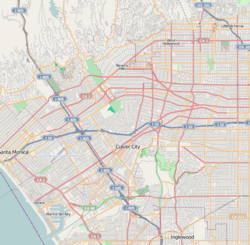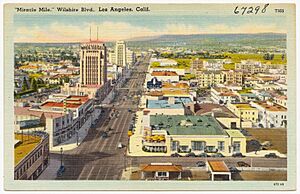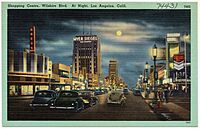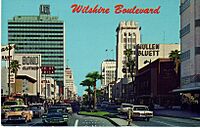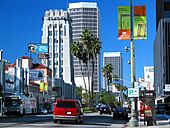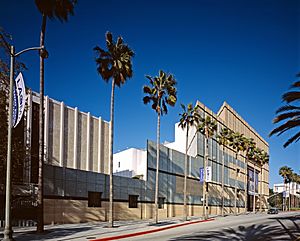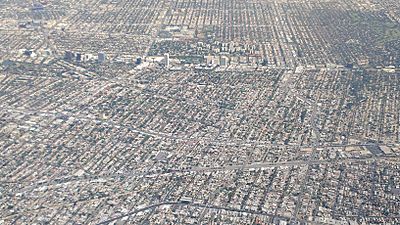Miracle Mile, Los Angeles facts for kids
Quick facts for kids
Miracle Mile
|
|
|---|---|

Miracle Mile Neighborhood sign
located at the intersection of San Vicente Boulevard & Hauser Boulevard |
|
| Country | |
| State | |
| County | |
| Time zone | Pacific |
| Zip Code |
90036, 90019
|
| Area code(s) | 323 |
Miracle Mile is a neighborhood in Los Angeles, California. It is famous for its museums and unique history. This area includes a part of Wilshire Boulevard called "Museum Row." It also has special areas called Historic Preservation Overlay Zones (HPOZs), which help protect older buildings.
Contents
Exploring Miracle Mile
Where is Miracle Mile?
Miracle Mile is located in the heart of Los Angeles. Its main borders are 3rd Street to the north and San Vicente Boulevard to the south. On the east, you'll find Highland Avenue, and on the west, Fairfax Avenue. Important streets running through it include Wilshire and Olympic boulevards.
How Miracle Mile Began
In the early 1920s, the area that is now Miracle Mile was mostly farmland. A smart developer named A. W. Ross saw its potential. He wanted to create a new shopping area that would be as important as downtown Los Angeles. He designed Wilshire Boulevard to be perfect for cars, which was a new idea at the time. The name "Miracle Mile" first appeared in newspapers in 1929.
Ross made sure the street had special features for cars. These included dedicated left-turn lanes and timed traffic lights, which were the first in the United States. He also required stores to have parking lots. This made it easy for people to drive and shop. Major stores like May Company and Desmond's opened here. Ross even asked architects to design buildings that looked good when seen from a car driving at 30 miles per hour. These designs helped create the Art Deco and Streamline Moderne styles seen in the area.
Ross's ideas were very successful. He created a new way for cities to grow, focusing on cars. This helped make Los Angeles known as a city where cars are very important. A statue of A. W. Ross stands at 5800 Wilshire Boulevard, honoring his vision.
The area became very popular and was called "America's Champs-Élysées." Even though shopping malls later became popular, Miracle Mile has stayed important. It has many museums and tall office buildings today.
The Deco Building at 5209 Wilshire is a famous Art Deco building. It was built in 1929 and is listed on the National Register of Historic Places.
Famous Buildings and Businesses
Miracle Mile has been home to many important buildings and businesses over the years. Here are some notable ones:
- 6060 Wilshire: This building once housed the Seibu Department Store. Today, it is the Petersen Automotive Museum.
- 6067 Wilshire: The historic May Company building, built in 1940, is now the Saban Building. It is home to the Academy Museum of Motion Pictures.
- 5900 Wilshire: A tall office building completed in 1971.
- 5905 Wilshire: This is where the Los Angeles County Museum of Art (LACMA) is located.
- 5801 Wilshire: Home to the La Brea Tar Pits and George C. Page Museum.
- 5757 Wilshire: The Prudential Building, now called Museum Square, is home to SAG-AFTRA.
- 5601 Wilshire: The location of Du-Par's, a well-known restaurant.
- 5515 Wilshire: The El Rey Theatre (Los Angeles), a historic movie theater built in 1936.
- 5522 Wilshire: The Wilshire Tower Building, built in 1928–29, once housed stores like Silverwoods and Desmond's. Today, it includes the ACE Gallery.
- 5207–9 Wilshire: The Security-First National Bank building, built in 1929, is now known as The Deco Building.
Museum Row


Miracle Mile is famous for its "Museum Row." This stretch of Wilshire Boulevard has several major museums close to each other. These include:
- The Los Angeles County Museum of Art (LACMA)
- The Petersen Automotive Museum
- Craft Contemporary
- The George C. Page Museum and the La Brea Tar Pits
The Academy Museum of Motion Pictures, which celebrates movies, is also part of Museum Row. It is located in the old May Company building at Wilshire Boulevard and Fairfax Avenue.
Historic Preservation Areas
Miracle Mile has two special areas called Historic Preservation Overlay Zones (HPOZs). These zones help protect the unique look and history of the neighborhood.
- The Miracle Mile HPOZ covers 1,347 properties. It includes the area from Wilshire Boulevard to San Vicente Boulevard, and from La Brea Avenue to Orange Grove Avenue.
- The Miracle Mile North HPOZ mainly has single-family homes built between 1924 and 1941. These homes have a similar style and size. This zone is located between Gardner and Detroit streets, from Beverly Boulevard to Third Street.
Getting Around Miracle Mile
The Los Angeles Metro's D Line subway runs along Wilshire Boulevard. This subway line has been extended to the Veterans Affairs Hospital.
For many years, there was a ban on digging subway tunnels in this area. This was because of a gas buildup from old oil wells that caused an explosion in 1985. However, by late 2005, new tunneling methods made it safe to build there again. The subway extension project received a lot of support and funding. As of July 2025, the D Line has new stations at La Brea, Fairfax, and La Cienega.
Education
The schools in this area are part of the Los Angeles Unified School District.
Landmarks to See
Besides the museums, Miracle Mile has many other interesting landmarks:
- The Los Angeles County Museum of Art
- The Petersen Automotive Museum
- SAG-AFTRA (a union for actors and media professionals)
- The El Rey Theatre
- La Brea Tar Pits
- Park La Brea Apartments
- 5900 Wilshire (an office building)
- Ace Gallery
- The Zachary All building (at 5467 Wilshire)
- The Olympia Medical Center
- The Academy Museum of Motion Pictures
- Johnie's Coffee Shop, often used for movies.
- Near the borders, you can find the Writers Guild of America, West, the Farmers Market, and The Grove.
See also
- Harold A. Henry, a former president of the Los Angeles City Council
- Ace Gallery


